Thermofluid Modelling of Large-Scale Orchards for Optimal Design and Control of Active Frost Prevention Systems
Abstract
1. Introduction
2. Parametric Computational Thermofluid Dynamics Model Development
2.1. Orchard Parameters and Computational Domain
2.2. CFD for Canopy Air Flows
2.3. CFD-Based Thermophysics Analysis of Frost in Fruit Orchards
2.4. Boundary Conditions
2.5. Validity of the Developed Model
2.6. Parametric CTFD Model Simulation Procedure
- For each zone in Figure 1, a separate controller is to be used for controlling blow of heated air on trees. Let us denote the controller for the i-th zone as , , where n is the number of zones.
- Controllers must work independently of each other.
- Set the control-time step (which is the time interval at which a controller provides a fixed control input of either zero heat flux or the possible maximum heat flux to the orchard) to . In fact, can be considered as a “simulation parameter” and can be set to different values depending on the frost scenario. For example, in case of severe frosts can be set to lower values, such as to 10 s.
- In principle, can be different for each , but better to be the same to simplify the simulation procedure.
- Let the heat flux provided to each zone by be with minimum and maximum values of and , respectively. can be set to zero simply and depends on the capacity of air heaters. Let the control period over which to control the orchard be divided into a set of N intervals where the length of each interval is . Let us denote the time points at the beginning of each interval by . , , , is determined as follows. For zone i at time , calculate the average temperature of each tree in the zone and let be the minimum of all these calculated average tree temperatures. Then, determine as:
3. Case Study: Use of Parametric CTFD Model for Frost Preventing Energy Calculations
Results and Discussions
4. Thermofluid Modelling for Optimal Design and Control of Active Frost Prevention Systems Integrating Renewable Energy
5. Conclusions and Recommendations
Author Contributions
Funding
Conflicts of Interest
Nomenclature
| Acronym/Symbol | Description |
| CFD | Computational fluid dynamics |
| CTFD | Computational thermofluid dynamics |
| PID | Proportional-integral-derivative |
| RANS | Reynolds-averaged Navier–Stokes |
| Ground area of the tree canopy | |
| Area of the tree stem | |
| C | Cloud cover constant |
| The group of grid cells located within trees | |
| Pressure loss coefficient | |
| Specific heat of leaves | |
| d | Tree diameter |
| E | Total air energy |
| g | Gravitational acceleration |
| h | Sensible air enthalpy |
| H | Height of trees |
| J | Diffusion flux |
| k | Turbulent kinetic energy |
| Effective air conductivity | |
| L | Length of the orchard |
| Characteristic length of leaves | |
| p | Air pressure |
| The aerodynamic resistance of the leaf boundary layer | |
| s | Distance between roots of trees |
| Thickness of leaves | |
| u | Air velocity |
| Buoyancy air velocity | |
| Wind speed | |
| The convective heat exchange between tree canopy and the surrounding air | |
| Conductive heat flux between the ground and tree canopy | |
| Radiation heat flux from sky to tree canopy | |
| Outgoing radiation from tree canopy | |
| Relative humidity | |
| Air source term | |
| Sensible heat exchange between the trees and air | |
| Sensible heat generation from heaters inside the orchard | |
| Source term for momentum loss due to tree canopies | |
| T | Air temperature |
| Canopy temperature | |
| Ground temperature | |
| Sky temperature | |
| U | Conductance of the tree stem |
| w | Specific dissipation rate |
| W | Width of the orchard |
| Emissivity | |
| Air density | |
| Tree canopy density | |
| Air viscosity | |
| Turbulent air viscosity | |
| Stefan–Boltzmann constant |
References
- The Fruit and Vegetable Sector in the EU—A Statistical Overview. 2018. Available online: http://ec.europa.eu/eurostat (accessed on 8 December 2019).
- Gunduz, O.; Ceyhan, V.; Bayramoglu, Z. Influence of climatic factors on apricot (Prunus armeniaca L.) yield in the Malatya province of Turkey. Asian J. Agric. Sci. 2011, 3, 150–155. [Google Scholar]
- Batmaz, M.F. Studies on Some Apricot Genotypes under Adana Ecological Conditions. Master’s Thesis, Cukurova University, Adana, Turkey, 2005. (In Turkish). [Google Scholar]
- Perry, K.B. Basics of frost and freeze protection for horticultural crops. HorthTechnology 1988, 8, 10–15. [Google Scholar] [CrossRef]
- De Melo-Abreu, J.P.; Villalobus, F.J.; Mateos, L. Principles of Agronomy for Sustainable Agriculture; Springer: Berlin, Germany, 2016; Chapter 29; pp. 443–457. [Google Scholar]
- Avissar, R.; Mahrer, Y. Mapping frost-sentive areas with a three-dimensional local-scale numerical model. Part I: Physical and numerical aspects. J. Appl. Meteorol. 1988, 27, 400–413. [Google Scholar] [CrossRef]
- Robinson, C.; Mort, N. A neural network system for the protection of citrus crops from frost damage. Comput. Electron. Agric. 1997, 16, 177–187. [Google Scholar] [CrossRef]
- Prabha, T.; Hoogenboom, G. Evaluation of the weather research and forecasting model for two frost events. Comput. Electron. Agric. 2008, 64, 234–247. [Google Scholar] [CrossRef]
- Rahimi, M.; Eccel, E. Modelling the effects of meteorological and geographical drivers on damage from late radiation frost on apple trees in Northeast Iran. Ital. J. Agrometeorol. 2016, 3, 13–22. [Google Scholar]
- Issa, R.J. Numerical heat transfer model for frost protection of citrus fruits by water from a spraying system. Therm. Sci. 2012, 16, 31–42. [Google Scholar] [CrossRef]
- Wu, W.; Hu, Y.; Yang, S.; Mao, K.; Zhu, X.; Li, P. Optimal design of wind machine impeller for frost protection based on CFD and its field test on airflow disturbance. Int. J. Agric. Biol. Eng. 2015, 8, 43–49. [Google Scholar]
- Green, R.S. Modelling turbulent air flow in a stand of widely-spaced trees. Phoenics J. 1992, 5, 294–312. [Google Scholar]
- Gros, G. Numerical Simulation of Canopy Flows; Springer: Berlin, Germany, 1993; pp. 34–91. [Google Scholar]
- Hong, S.W.; Zhao, L.; Zhu, H. CFD simulation of airflow inside tree canopies discharged from air-assisted sprayers. Comput. Electron. Agric. 2018, 149, 121–132. [Google Scholar] [CrossRef]
- Bjerg, B.; Cascone, G.; Lee, I.B.; Bartzanas, T.; Norton, T.; Hong, S.W.; Seo, I.H.; Banhazi, T.; Liberati, P.; Marucci, A.; et al. Modelling of ammonia emissions from naturally ventilated livestock buildings. Part 3: CFD modelling. Biosyst. Eng. 2013, 116, 259–275. [Google Scholar] [CrossRef]
- Hong, S.W.; Zhao, L.; Zhu, H. CFD simulation of pesticide spray from air-assisted sprayers in an apple orchard: Tree deposition and off-target losses. Atmos. Environ. 2018, 175, 109–119. [Google Scholar] [CrossRef]
- Tennekes, H.; Lumley, J.L. A First Course in Turbulence; The MIT Press: Cambridge, MA, USA; London, UK, 1972. [Google Scholar]
- Ansys, Inc. ANSYS Fluent 18 Theory Guide; Ansys, Inc.: Canonsburg, PA, USA, 2017. [Google Scholar]
- Goforth, M.A.; Gilcrest, G.W.; Sirianni, J.D. Cloud effects on thermal downwelling sky radiance. Proc. SPIE 2002, 4710, 203–213. [Google Scholar]
- Swinbank, W.C. Long-wave radiation from clear skies. Q. J. R. Meteorol. Soc. 1963, 89, 339–348. [Google Scholar] [CrossRef]
- Roy, J.C.; Boulard, T.; Kittas, C.; Wang, S. Convective and ventilation transfers in greenhouses, Part 1: The greenhouse considered as a perfectly stirred tank. Biosyst. Eng. 2002, 83, 1–20. [Google Scholar] [CrossRef]
- Jayalakshmy, M.S.; Philip, J. Thermophysical properties of plant leaves and their influence on the environment temperature. Int. J. Thermophys. 2010, 31, 2295–2304. [Google Scholar] [CrossRef]
- Hong, S.W.; Zhao, L.; Zhu, H. SAAS: A computer program for estimating pesticide spray efficiency and drift of air-assisted pesticide applications. Comput. Electron. Agric. 2018, 155, 58–68. [Google Scholar] [CrossRef]
- Ghaemi, A.A.; Rafiee, M.R.; Sepaskhah, A.R. Tree-temperature monitoring for frost protection of orchards in semi-arid regions using sprinkler irrigation. Agric. Sci. China 2009, 8, 98–107. [Google Scholar] [CrossRef]
- Atam, E.; Arteconi, A. Green energy-assisted frost prevention: A conceptual framework. Energy Procedia 2017, 141, 155–159. [Google Scholar] [CrossRef]
- Atam, E.; Helsen, L. Ground-coupled heat pumps: Part 1—Literature review and research challenges in modeling and optimal control. Renew. Sustain. Energy Rev. 2016, 54, 1653–1667. [Google Scholar] [CrossRef]
- Atam, E.; Helsen, L. Ground-coupled heat pumps: Part 2—Literature review and research challenges in optimal design. Renew. Sustain. Energy Rev. 2016, 54, 1668–1684. [Google Scholar] [CrossRef]
- Atam, E.; Patteeuw, D.; Antonov, S.P.; Helsen, L. Optimal control approaches for analysis of energy use minimization of hybrid ground-coupled heat pump systems. IEEE Trans. Control. Syst. Technol. 2016, 24, 525–540. [Google Scholar] [CrossRef]
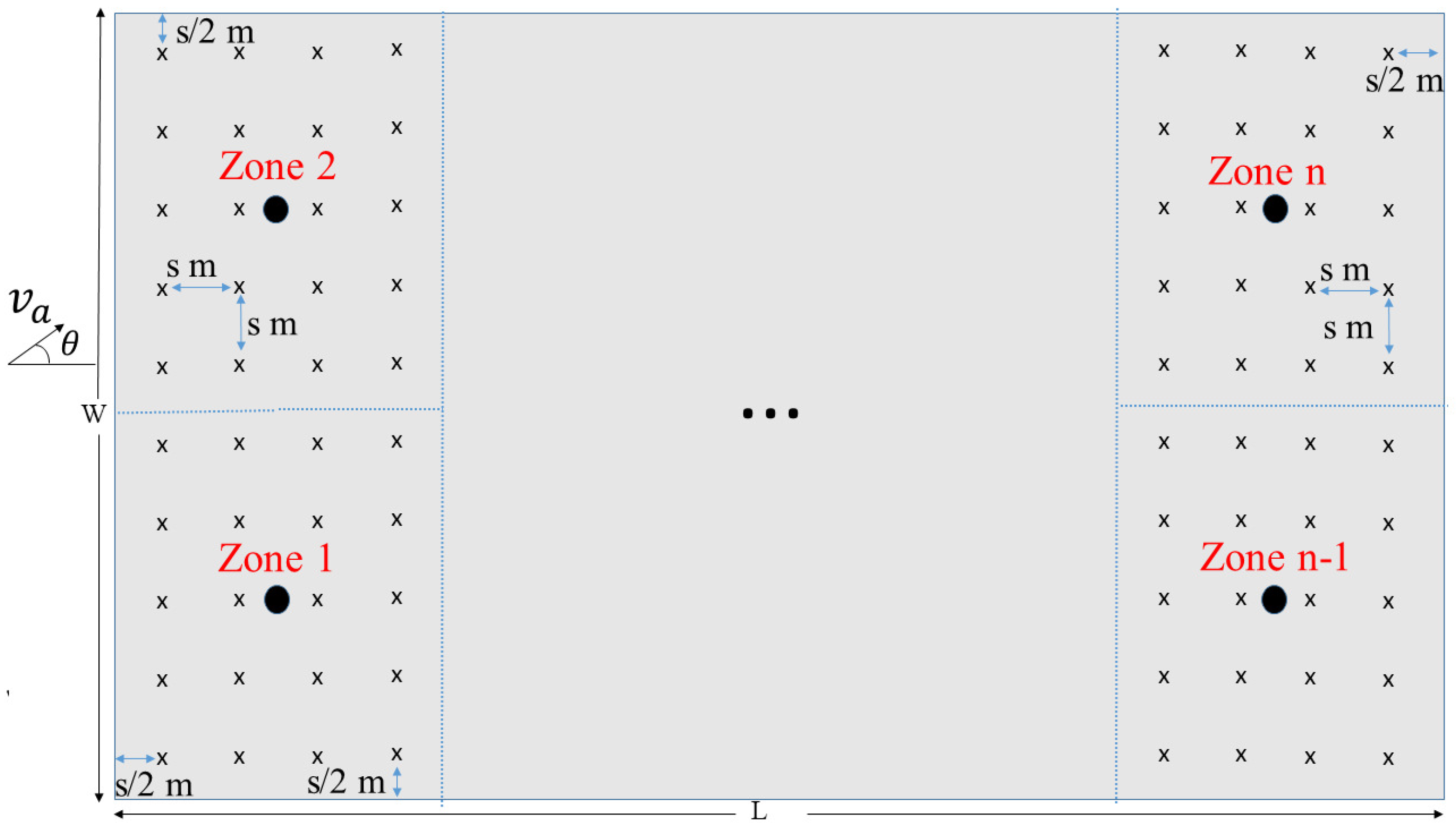
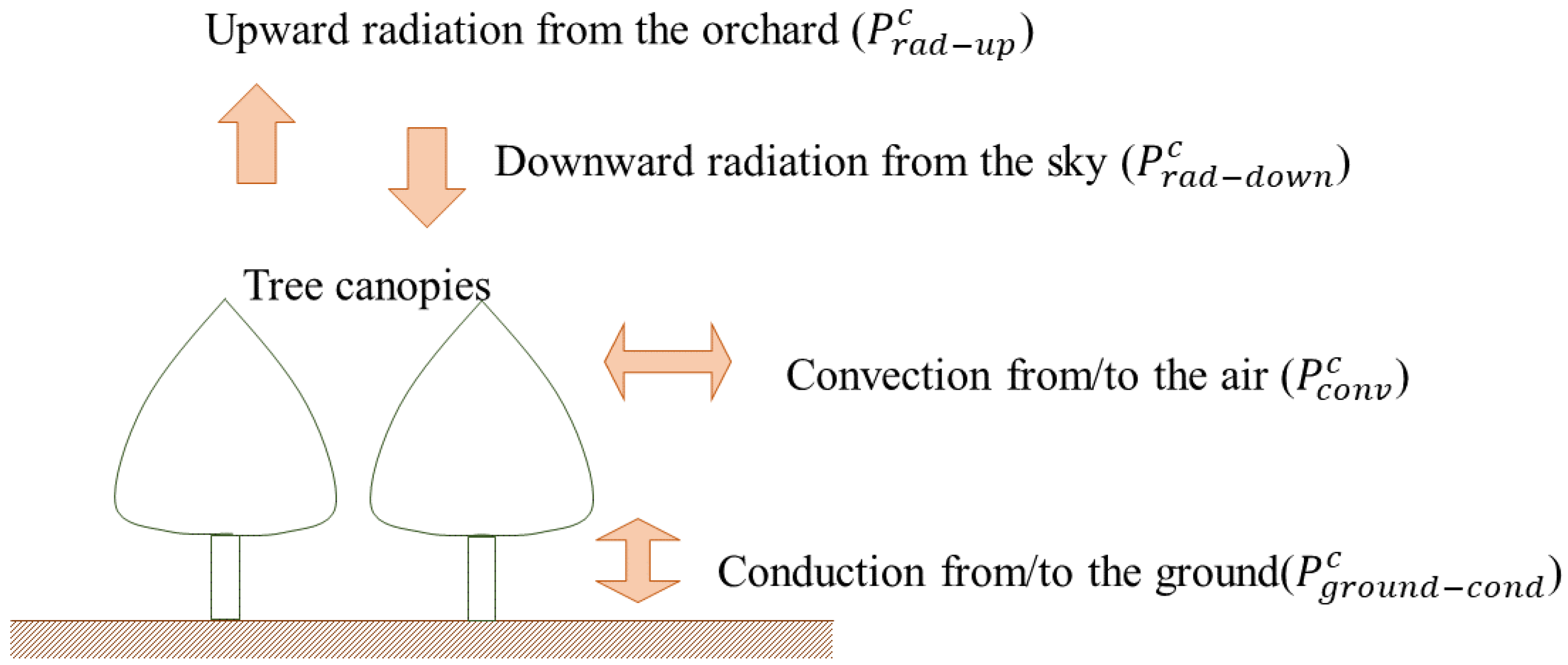
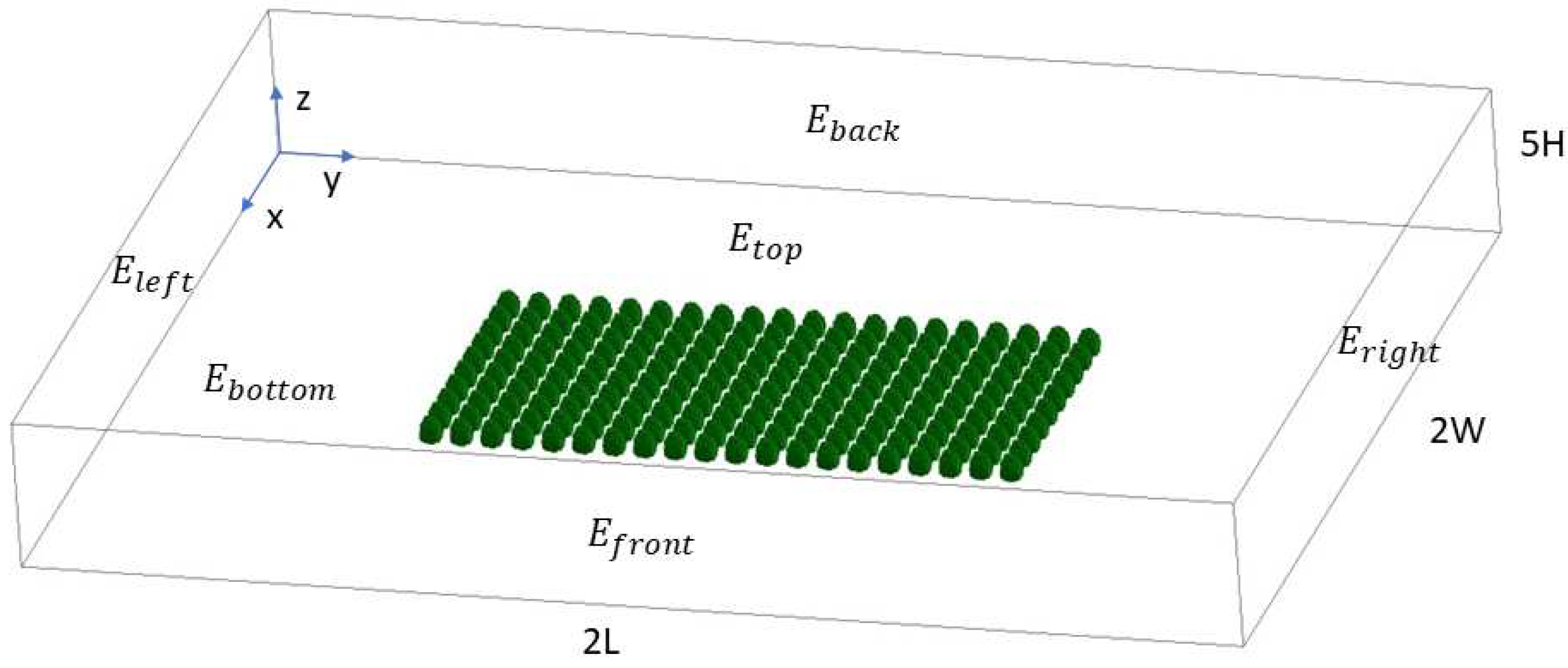
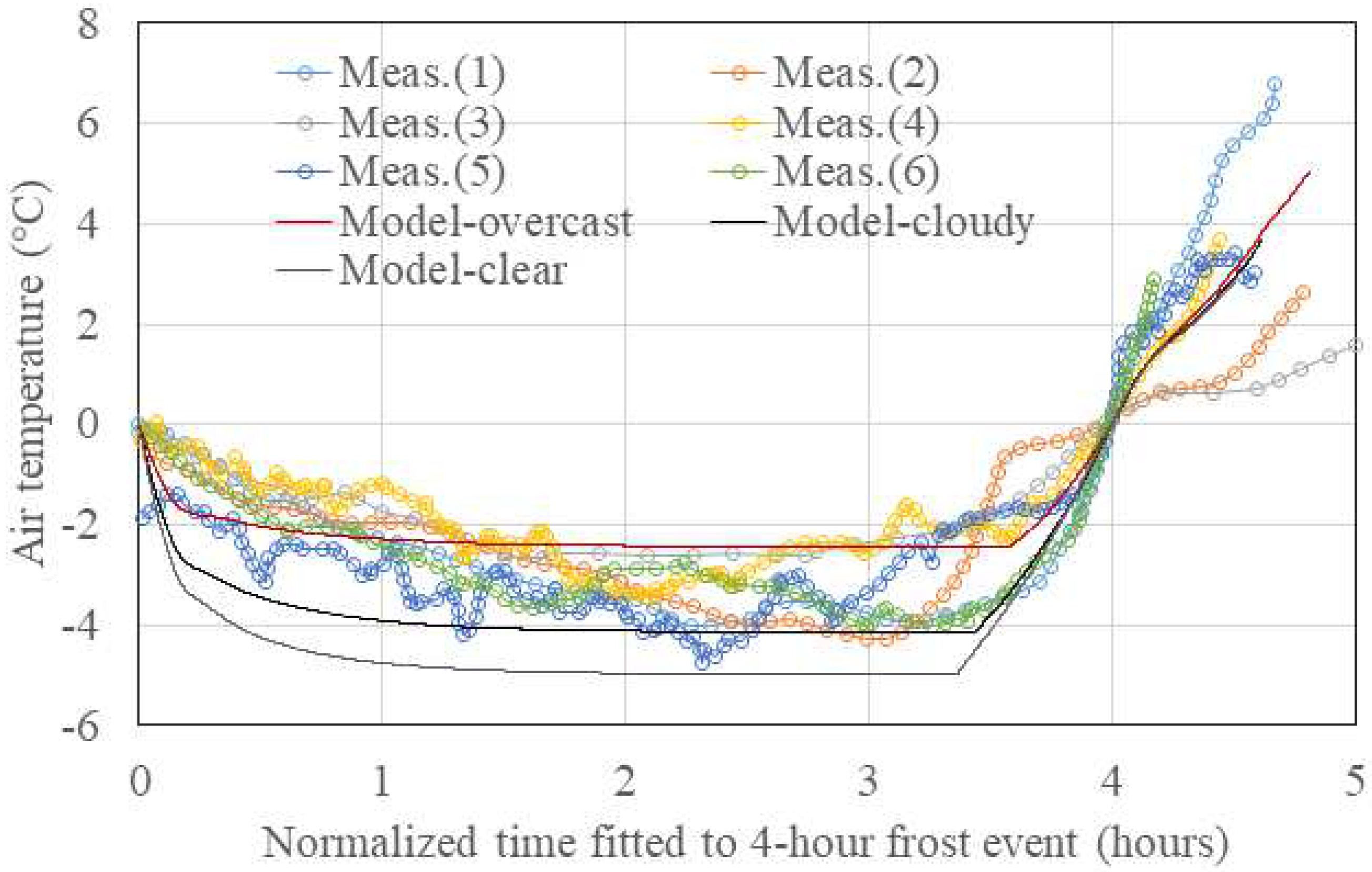

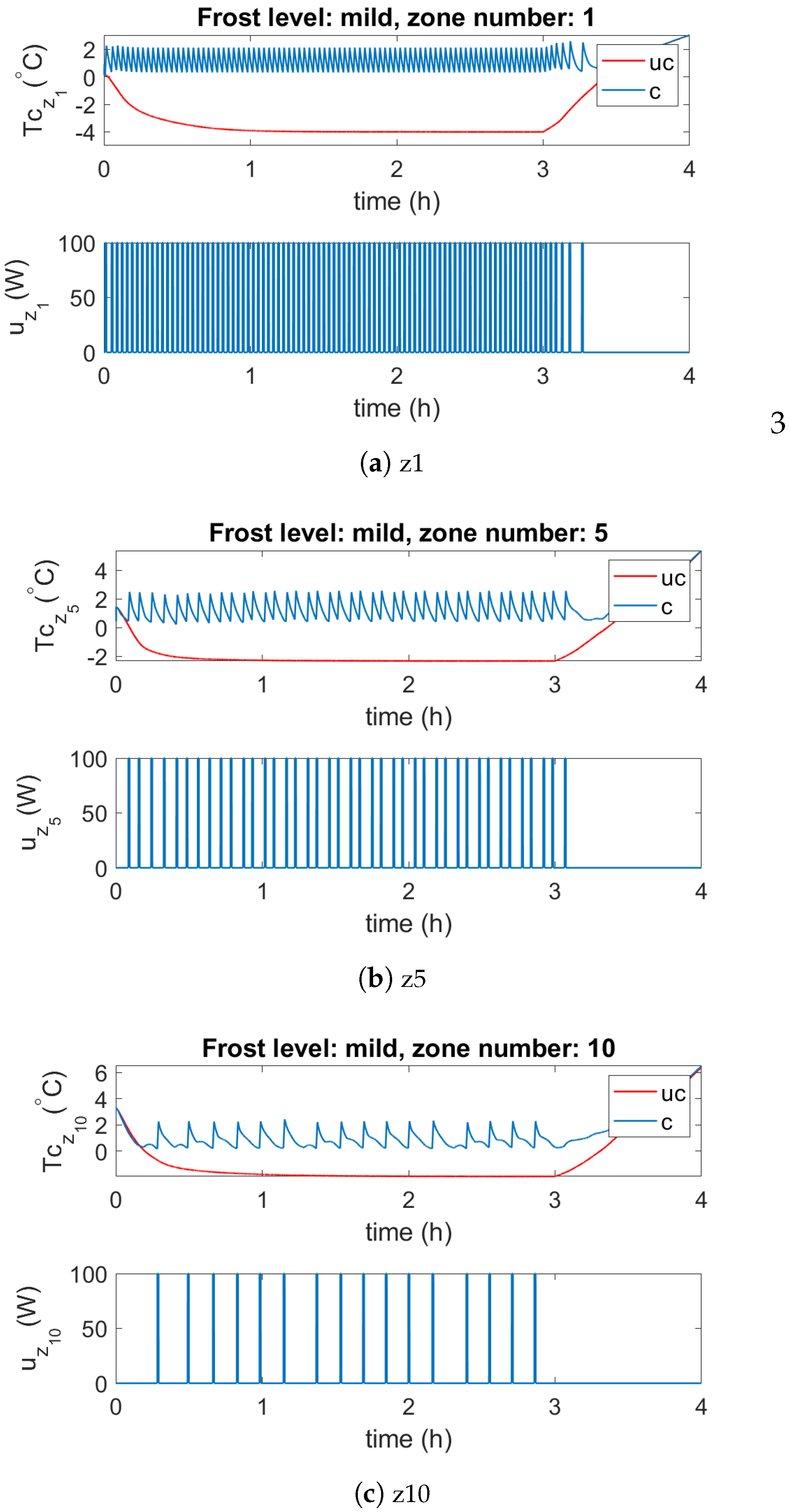
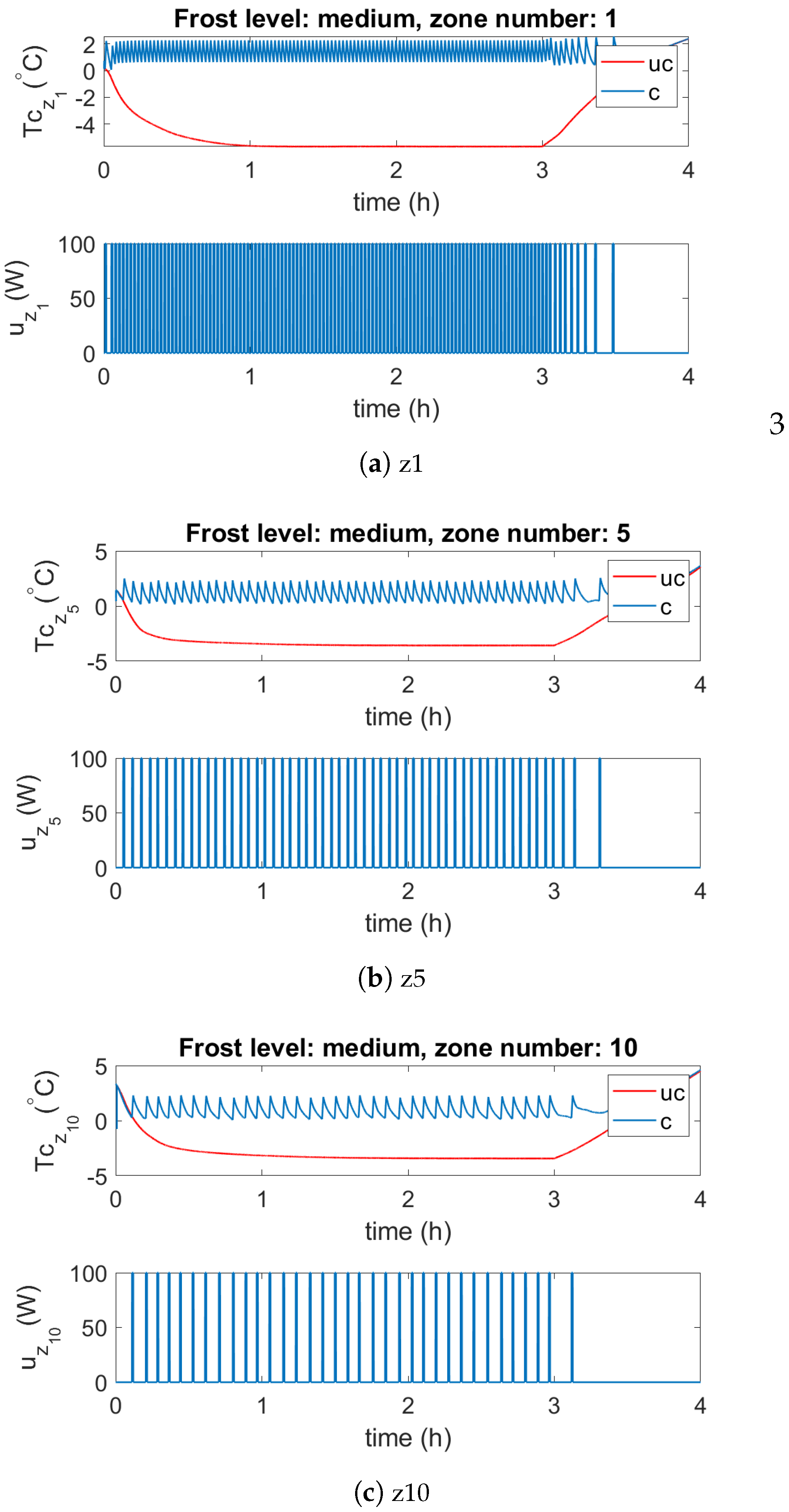
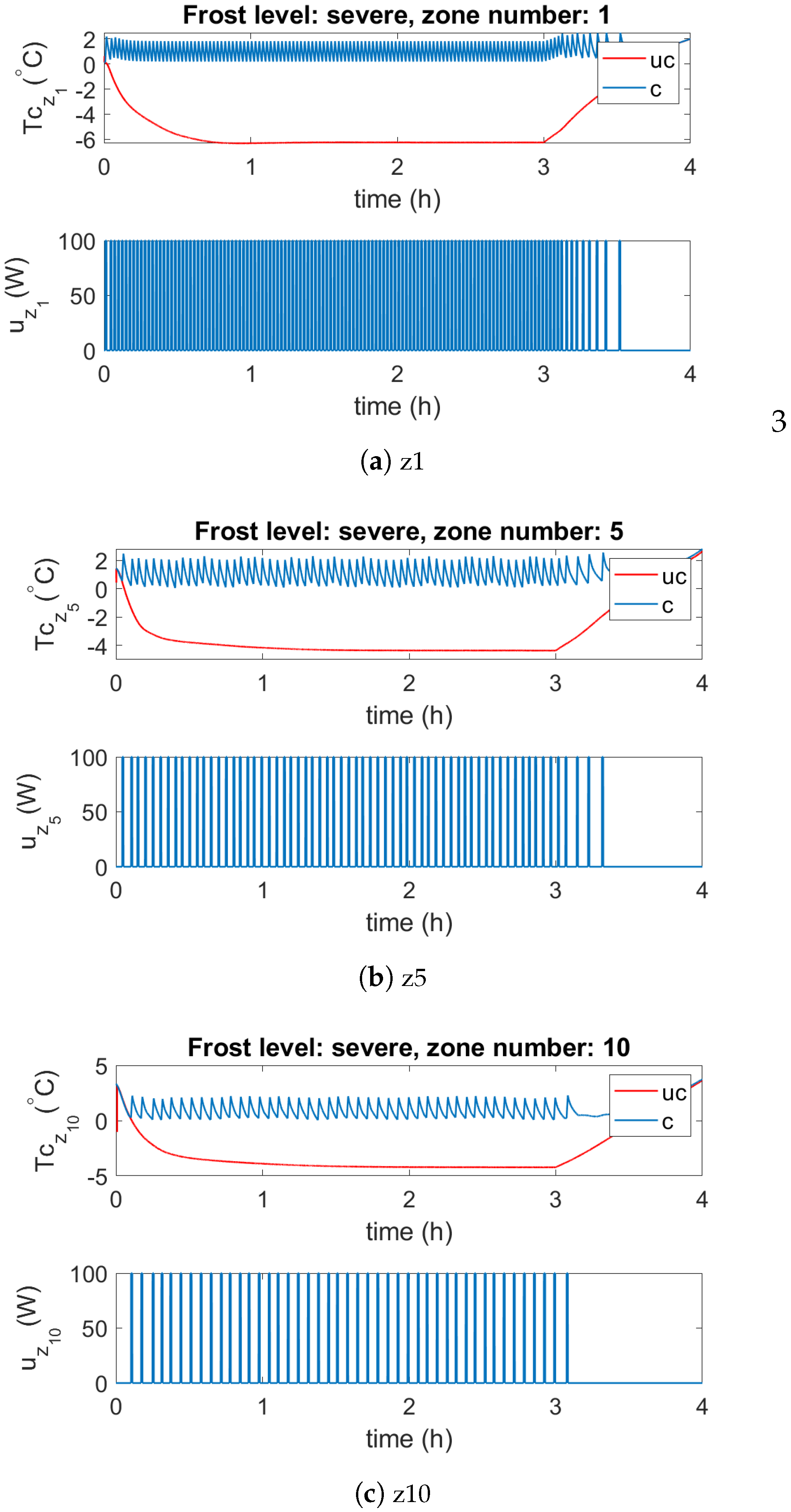
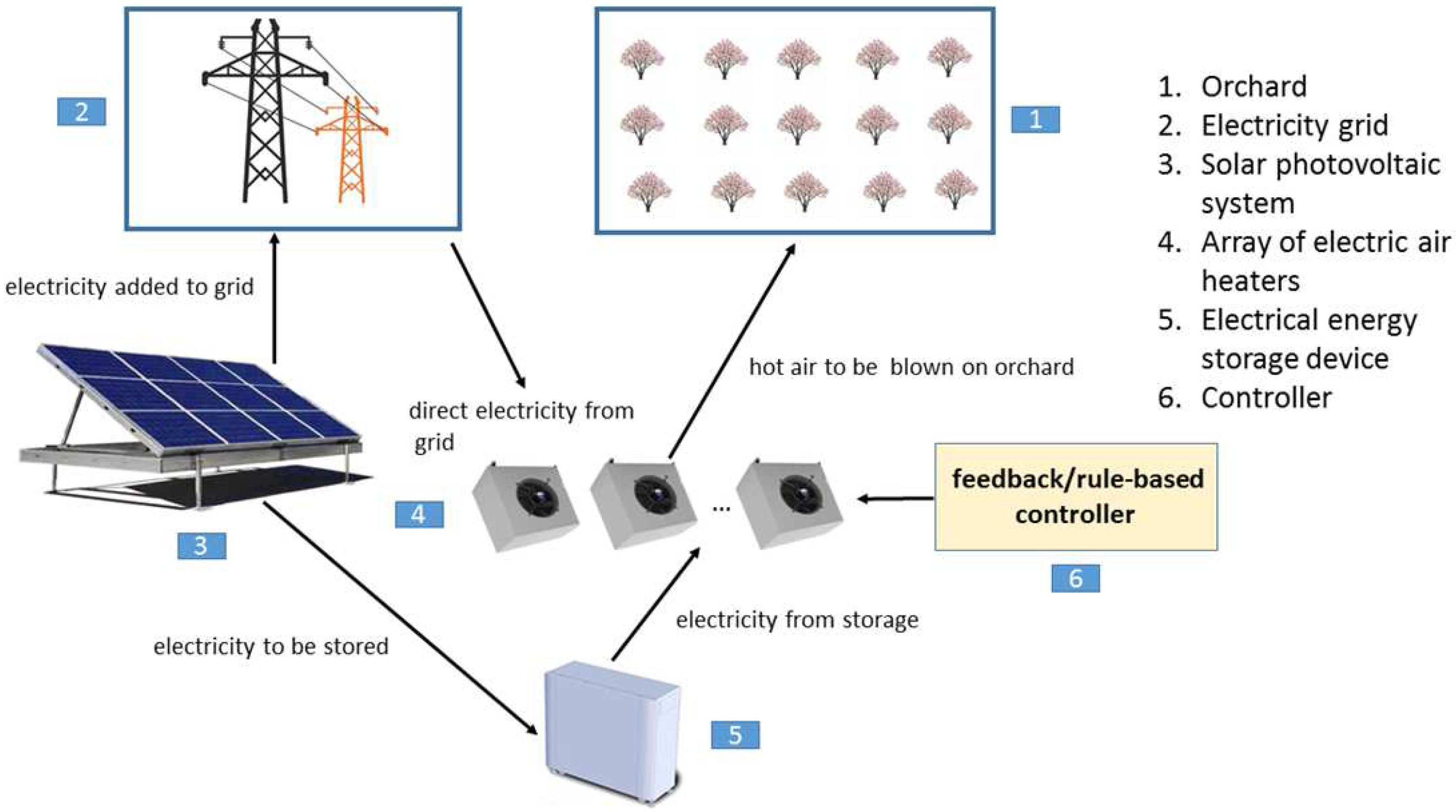
| Variable Description | Variable Notation |
|---|---|
| Canopy width (m) | |
| Tree height (m) | |
| Trunk diameter (m) | |
| Trunk height (m) | |
| Leaf area index () | |
| Leaf area density () | |
| Leaf characteristic dimension (m) |
| Variables | Values |
|---|---|
| Canopy width (m) | 6.0 |
| Tree height (m) | 9.0 |
| Trunk diameter (m) | 0.4 |
| Trunk height (m) | 1.5 |
| Leaf area index () | 3.0 |
| Leaf area density () | 2.0 |
| Leaf characteristic dimension (m) | 0.1 |
| Frost Condition | Sky Condition | Active Heater Operation Times | ||||||||||
| z1 | z2 | z3 | z4 | z5 | z6 | z7 | z8 | z9 | z10 | Total | ||
| Mild frost | Overcast | 48 | 48 | 22 | 22 | 21 | 21 | 11 | 11 | 8 | 8 | 220 |
| Medium frost | Cloudy | 65 | 65 | 32 | 32 | 29 | 29 | 20 | 21 | 18 | 18 | 329 |
| Severe frost | Clear | 67 | 67 | 38 | 38 | 34 | 34 | 26 | 26 | 23 | 23 | 376 |
| Frost Condition | Sky Condition | Energy Demand of Each Zone (kWh) [Heating Rate Was 100W/] | ||||||||||
| z1 | z2 | z3 | z4 | z5 | z6 | z7 | z8 | z9 | z10 | Total | ||
| Mild frost | Overcast | 160 | 160 | 72 | 72 | 71 | 71 | 36 | 36 | 28 | 28 | 734 |
| Medium frost | Cloudy | 217 | 217 | 107 | 107 | 96 | 96 | 67 | 69 | 60 | 60 | 1096 |
| Severe frost | Clear | 222 | 222 | 127 | 127 | 112 | 112 | 86 | 86 | 78 | 78 | 1250 |
© 2020 by the authors. Licensee MDPI, Basel, Switzerland. This article is an open access article distributed under the terms and conditions of the Creative Commons Attribution (CC BY) license (http://creativecommons.org/licenses/by/4.0/).
Share and Cite
Atam, E.; Hong, S.-W.; Arteconi, A. Thermofluid Modelling of Large-Scale Orchards for Optimal Design and Control of Active Frost Prevention Systems. Energies 2020, 13, 378. https://doi.org/10.3390/en13020378
Atam E, Hong S-W, Arteconi A. Thermofluid Modelling of Large-Scale Orchards for Optimal Design and Control of Active Frost Prevention Systems. Energies. 2020; 13(2):378. https://doi.org/10.3390/en13020378
Chicago/Turabian StyleAtam, Ercan, Se-Woon Hong, and Alessia Arteconi. 2020. "Thermofluid Modelling of Large-Scale Orchards for Optimal Design and Control of Active Frost Prevention Systems" Energies 13, no. 2: 378. https://doi.org/10.3390/en13020378
APA StyleAtam, E., Hong, S.-W., & Arteconi, A. (2020). Thermofluid Modelling of Large-Scale Orchards for Optimal Design and Control of Active Frost Prevention Systems. Energies, 13(2), 378. https://doi.org/10.3390/en13020378







